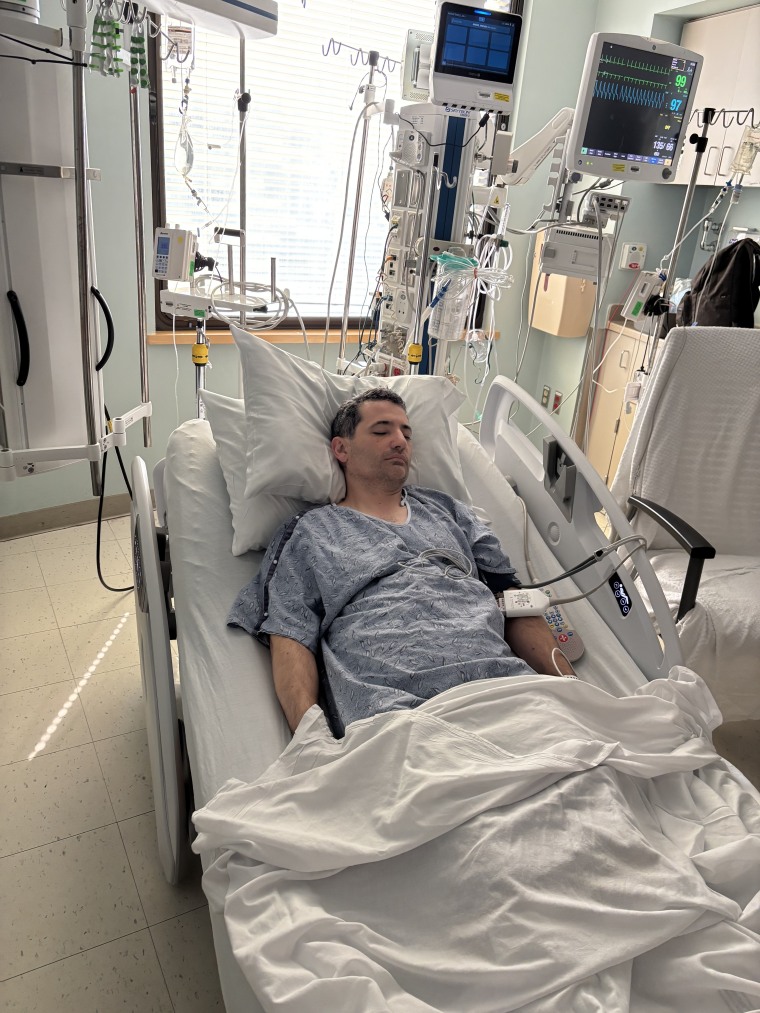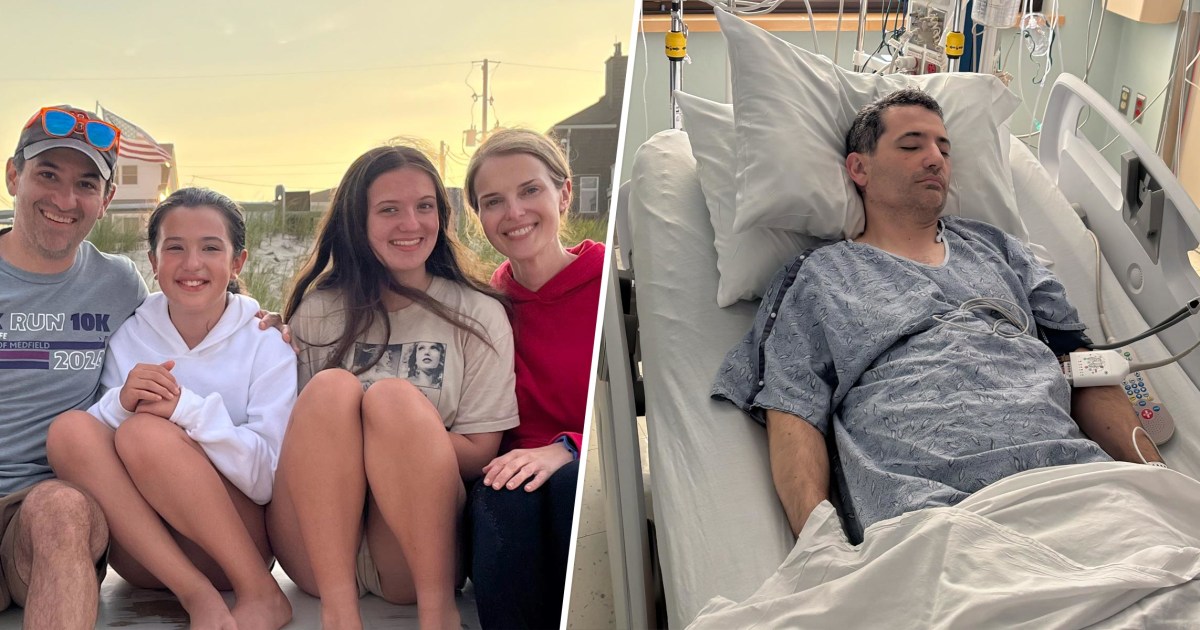For Stephen Greene, an attorney and father of two, the first symptoms of a brain tumor were subtle — and not obviously linked.
He first noticed a tingling on the right side of his tongue and a slight loss of hearing in his right ear during the spring of 2024, when he was 44 years old.
“I thought maybe I had a little bit of earwax or water in my ear, or I thought maybe I was getting over COVID,” Greene, of Medfield, Massachussetts, tells TODAY.com.
Greene went to his doctor, who didn’t notice anything obviously wrong with Greene’s ear, and sent him to an ear, nose and throat doctor. In June, he saw the ENT, who removed a little bit of wax, Greene recalls, and told him to monitor his symptoms.
“I honestly didn’t really notice any issues. The tongue thing persisted, but didn’t get worse,” he says. But by the time winter rolled around, Greene noticed his hearing had gotten significantly worse in that ear.
Greene and his wife go out to dinner once a week, and he’d started to notice that, “if I was not on her right side, I couldn’t hear the conversation.”
At that point, he says, “I realized my hearing was going on the right side, and at the same time, that numbness was spreading to my cheek area from just the tongue.”
This time, his doctor sent him to a different ENT, who suspected the issue may be brain-related and recommended Greene get an MRI and see a neurologist.
On April 11, 2025, almost exactly a year after his symptoms first began, Greene went for the brain MRI, which confirmed that the issue was neurological: Greene had a nearly golf ball-sized tumor pressing on the nerves responsible for hearing and facial sensations.
An MRI Revealed a Brain Tumor
Greene was diagnosed with a vestibular schwannoma, a type of non-cancerous tumor that grows out of the lining of a nerve in the inner ear, Dr. Omar Arnaout, a neurosurgeon who specializes in treating these tumors at Mass General Brigham, tells TODAY.com.
Specifically, the tumor develops from Schwann cells, which form the insulated lining of the vestibular nerves that are responsible for balance. But the vestibular nerves share that small inner ear canal with other nerves, including those responsible for hearing and facial sensations.
Of those nerves, the hearing nerve “is very fragile,” Arnaout explains. “It’s the most sensitive.” So, a tumor that grows on the vestibular nerve is likely to press on the hearing nerve and cause symptoms there first, he says.
Still, the symptoms of a vestibular schwannoma (also called a vestibular neuroma) tend to be less dramatic than those of other brain tumors, like glioblastomas.
“These are slow-growing, benign tumors, and the symptoms tend to be pretty subtle,” Arnaout explains. “So it’s very common for people to go a while before they get diagnosed.”
A story like Greene’s — a young, otherwise healthy person with subtle symptoms — is typical for patients who end up being diagnosed with this type of tumor, Arnaout says. Often, the first symptom is either decreased hearing, like Greene experienced, or tinnitus, a type of ringing or buzzing in the ears.
At first, people typically ignore these early mild symptoms, Arnaout says. But they don’t go away.
After a while, “the natural thing to do is to get a hearing test,” he explains, “and the test actually reveals a certain pattern of hearing loss that is associated more often than not with a tumor.”
In Greene’s case, he underwent two hearing tests. The first, in the spring of 2024, showed that he did have reduced hearing in one ear, but it was still within the range of normal, he recalls. The second happened the day before his MRI, at which point his hearing loss was much more profound.
“It was very frustrating because I could hear that a sound was being made, but I couldn’t distinguish what word was being spoken,” he says.
A Lengthy, Delicate Surgery
When these tumors are smaller, doctors might leave them alone and just monitor them, Arnaout says. “Sometimes we catch them and they’re like the size of a grain of rice or a raisin,” he says.
But when they’re more medium-sized, like Greene’s 3-centimeter tumor, “they start to push up against the brainstem, and now you’re having a little bit of a different conversation,” says Arnaout, who was one of the surgeons who performed Greene’s brain surgery.
If left untreated, the tumor could continue to grow and cause more severe — potentially life-threatening — issues.

Greene underwent surgery, most of which was performed by a neurosurgery team (including Arnaout in his case) and handed off to an ear surgeon in the final stages. It’s not uncommon for these surgeries to be quite long, Arnaout says, and Greene’s was around 12 to 13 hours.
The brain surgery team creates the opening, takes the pressure off the brainstem, and starts the delicate work around the nerves until the team gets to the ear canal, Arnaout explains, at which point the ear surgery team takes over.
In Greene’s case, the surgeons decided to leave a small bit (about 5%) of the tumor behind to reduce the risk of facial paralysis.
‘You Can’t Control It, But You Can Handle It’
Greene’s surgery was successful and he did not have any facial paralysis. But the hearing he lost is permanently gone. He’ll be meeting with a specialist in January to discuss possible implants or other devices.
And his recovery has been long and challenging in other ways, he says. Waking up after surgery, “there’s double vision, there’s certainly brain fog, not being able to remember or kind of get your thoughts across,” Greene recalls.
He also had to “relearn to walk a little bit.” He used a walker for a week, then a cane for another week after the surgery, which Arnaout says is not unusual for cases like Greene’s.
Today, he is still in physical therapy to address balance and stability issues, he says. And because his vocal cords were affected, his speech is “still a little gravelly and off,” Greene says.
Greene also had a heart issue that required surgery and prolonged his recovery even further. “I ended up being in the ER six different times in about five or six weeks because I just couldn’t control my heartbeat,” he says.
In just the last month, since getting the heart surgery, Greene has finally been able to take a breath and get back to what he loves doing.

In mid-September, for instance, he was able to go to a Red Sox game with his 12-year-old daughter. “It was really nice to be at Fenway Park and feel normal and not dizzy, overwhelmed or like I might have to run to an ER at any second.” And Greene and his wife decided to plan a spontaneous trip to Disney World later this year for their family.
The way friends have stepped up to help — even to come over and just sit quietly for an evening when Greene couldn’t be alone in case of an emergency — has also been eye-opening. And it’s shown Greene that he wants to be that kind of friend for others, he says.
Overall, the experience has been an exercise in letting go of control, being more comfortable not having conclusive answers and accepting help, Greene says.
“People tried to tell me that — my wife, my therapist, various friends — and it was hard to process that (before the surgery),” he says. “But I see it more now… You just can’t control things, but you’re able to handle them. No matter what comes, you’ll be able to handle it.”
First Appeared on
Source link












